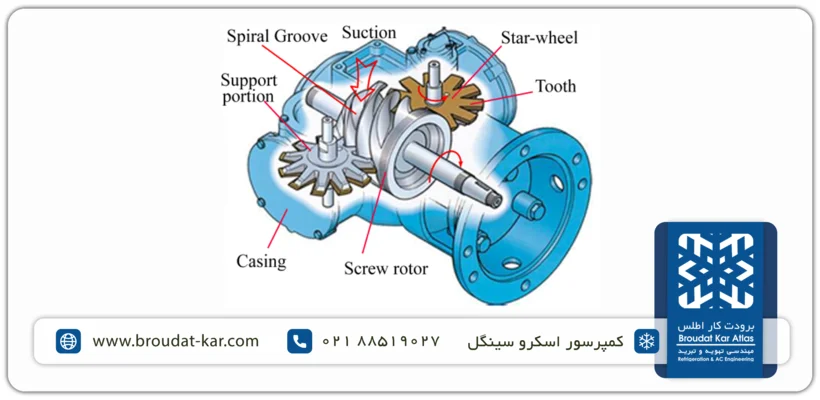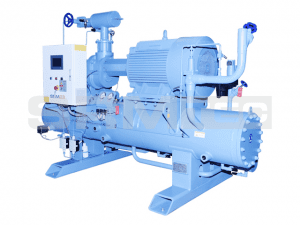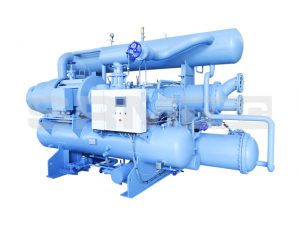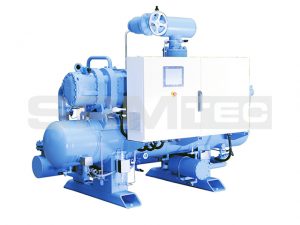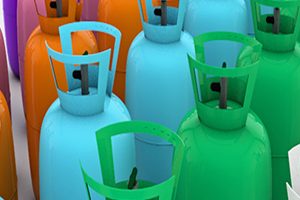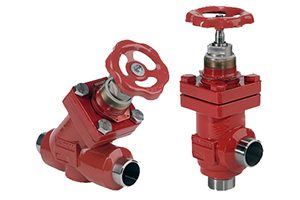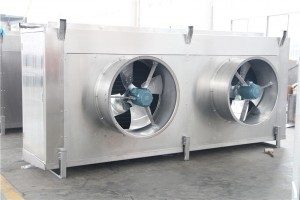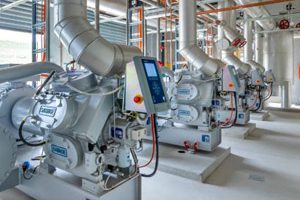What Is Ammonia Screw Compressor?
An ammonia screw compressor is a type of compressor used in industrial refrigeration systems to compress ammonia refrigerant gas. It consists of two interlocking helical rotors that compress the ammonia gas by reducing the volume between them. This compression process increases the pressure and temperature of the gas, allowing it to release heat and condense into a liquid state. Ammonia screw compressors are highly efficient and reliable, making them well-suited for large-scale refrigeration applications in industries such as food processing, cold storage, and HVAC systems.
Ammonia Screw Compressors Varieties
Mono Rotor Screw Compressors
Also known as single-screw compressors, mono rotor screw compressors feature one main rotor that rotates within a cylindrical housing. The rotor has helical lobes that mesh with the helical grooves in the cylinder wall. As the rotor turns, gas is drawn into the spaces between the lobes and the housing. Compression occurs as the gas travels along the length of the rotor and is gradually squeezed to a higher pressure. Mono rotor screw compressors are known for their simplicity, compact design, and suitability for small-scale applications such as refrigeration and air conditioning in residential and light commercial settings.
Twin Rotor Screw Compressors
Twin rotor screw compressors, also known as double-screw compressors, feature two intermeshing rotors that rotate in opposite directions within a casing. These rotors have complementary helical lobes that trap gas and progressively compress it as the rotors rotate. Twin rotor screw compressors are widely used in industrial applications where higher volumes of compressed air or gas are required. They are known for their high efficiency, reliability, and ability to handle a wide range of operating conditions. These compressors are commonly found in large-scale industrial refrigeration systems, manufacturing plants, and petrochemical facilities.
These two types of rotary screw compressors offer distinct advantages and are chosen based on the specific requirements of the application, including capacity, efficiency, and pressure levels.
Applications of Ammonia Screw Compressor
Ammonia screw compressors find wide-ranging applications across various industries, primarily in industrial refrigeration and HVAC systems.
In industrial refrigeration, these compressors play a critical role in maintaining the required temperatures for preserving goods and facilitating manufacturing processes. Cold storage warehouses and distribution centers rely on ammonia screw compressors to maintain low temperatures necessary for storing products such as food, pharmaceuticals, and chemicals. These compressors ensure reliable and efficient cooling, helping to extend the shelf life of perishable goods and prevent spoilage during storage and transportation.
Similarly, food processing plants utilize ammonia screw compressors to maintain precise temperature control during various stages of food production and storage. From chilling raw ingredients to freezing finished products, these compressors provide the necessary refrigeration capacity to meet stringent food safety and quality standards. In addition, ice production facilities depend on ammonia screw compressors to produce large quantities of ice for commercial and industrial use, including food service, fisheries, and concrete cooling applications.
In HVAC systems, ammonia screw compressors are employed in large-scale air conditioning systems and climate control applications in commercial and industrial buildings. These compressors offer high efficiency and reliability, making them suitable for cooling large spaces such as shopping malls, office complexes, and manufacturing facilities. They provide consistent and uniform cooling throughout the building, ensuring comfort for occupants while optimizing energy consumption and operating costs.
Overall, ammonia screw compressors play a vital role in a diverse range of applications within industrial refrigeration and HVAC systems, providing efficient and reliable cooling solutions for various industries and ensuring the preservation of perishable goods, comfort, and safety in commercial and industrial environments.
How Ammonia Screw Compressor Works
Screw compressors are a type of positive displacement compressor that use intermeshing helical rotors to compress gas or air. They consist of two main components: a pair of rotors and a casing.
The rotors are typically helical in shape, resembling large screws. One rotor is known as the male rotor, while the other is the female rotor. These rotors are precision-engineered to fit closely together within the compressor casing.
As the rotors rotate, they create a series of tight pockets or chambers between the lobes of the rotors and the inner surface of the casing. As the rotors continue to rotate, these pockets move along the length of the rotors, gradually reducing in size and compressing the ammonia gas trapped within them.
The compression process begins when the gas or air is drawn into the compressor through an inlet port. As the rotors rotate, the volume of the pockets decreases, causing the gas or air to be compressed. The compression continues until the compressed gas or air reaches the outlet port, where it is discharged from the compressor at a higher pressure.
Screw compressors are known for their continuous and smooth operation, as the compression process is achieved through the continuous rotation of the rotors. This results in minimal pulsation and vibration compared to other types of compressors.
Additionally, screw compressors are capable of delivering a constant flow of compressed gas or air, making them well-suited for applications where a steady supply of compressed air or gas is required.
Overall, screw compressors provide efficient and reliable compression for a wide range of industrial and commercial applications, including refrigeration, air conditioning, pneumatic tools, and manufacturing processes.
Design and Construction of Ammonia Screw Compressors
Material Selection
Ammonia screw compressors are often constructed using materials such as cast iron, stainless steel, or other corrosion-resistant alloys to withstand the corrosive nature of ammonia and operation heat.
Rotor Design
The rotors are the heart of a screw compressor. In ammonia screw compressors, the rotors typically have a specific helical profile optimized for efficient compression of ammonia gas. They are precision-machined to ensure tight tolerances and minimal leakage between the rotors and the compressor housing.
Compressor Casing
The compressor casing houses the rotors and provides support for the compression process. It is designed to withstand the high pressures generated during compression and may include features such as cooling jackets or fins to dissipate heat.
Cooling System
Ammonia screw compressors require effective oil cooling systems to maintain optimal operating performance. This may involve the use of water or refrigerant-based cooling circuits to remove heat generated during compression.
Drive System
Screw compressors are typically driven by electric motors. The drive system includes components such as belts, gears, or direct-drive arrangements to transfer power from the motor to the compressor rotors.
Components of Ammonia Screw Compressor
1- Rotor Assembly:
Consists of the male and female rotors that intermesh to compress the gas. The rotors are supported by high quality bearings.
2- Suction and Dis-charge Valves:
The supplied valves serve to isolate the compressor unit from the system during emergencies or servicing needs.
3- Oil Injection System:
Screw compressors require lubrication to reduce friction and wear between the rotors and casing. An oil injection system delivers lubricating oil to the compressor to ensure smooth operation.
4- Oil Separation System:
Since oil is injected into the compressor, an oil separation system is needed to remove oil from the compressed gas before it leaves for the condenser.
5- Control System:
Ammonia screw compressor units are equipped with sophisticated control systems (PLC) that monitor and regulate various parameters such as pressure, temperature, and speed to optimize performance and ensure safe operation.
Introduction to Ammonia Screw Compressors by SRM Company
In the early 1930s, the Swedish SRM company pioneered the development of screw compressors, presenting them as a highly effective solution across various industries. This groundbreaking innovation paved the way for numerous reputable companies worldwide to produce screw compressors under license from SRM, including Howden in England, Grasso in Netherland, Atlas Copco in Sweden, GM in America, Ingersoll Rand in America, Stall in Sweden, Hitachi in Japan, Mitsubishi in Japan, Linde in Germany, Sabroe in Denmark, Frick in America, Trane in America, Thermo King in America, Carrier in America, Gram in Denmark, Vilter in America, Ebara in Japan, Mycom in Japan, Kirloskar in India, Nanjing in China, and many others. As a result, SRM stands as the originator of screw compressors globally. Recently, SRM has established a factory in China to produce ammonia screw compressors of the highest quality and efficiency.
Considerations Before Purchasing an Ammonia Screw Compressor
When investing in an Ammonia Screw Compressor, it’s essential to carefully consider several factors to ensure optimal performance and compatibility with your refrigeration system. Here are some key considerations to keep in mind:
– Evaluate refrigeration system capacity and cooling requirements
– Consider reliability and durability for demanding industrial environments
– Assess energy efficiency and environmental impact for long-term cost savings and sustainability
– Ensure compatibility with existing system components
– Consider warranty coverage and availability of service and support
– Evaluate manufacturer or supplier reputation for reliability and ongoing maintenance support
By thoroughly evaluating these factors, you can make an informed decision and select the right Ammonia Screw Compressor that meets your specific needs and delivers reliable and efficient refrigeration performance for your industrial applications.
Ammonia Screw Compressor Price
When considering the price of an Ammonia Screw Compressor, it’s essential to recognize that several factors influence its cost. The price of these compressors can vary depending on several key factors such as capacity, efficiency, brand reputation, and additional features or customization options. Larger capacity compressors typically command higher prices due to the increased materials and manufacturing costs involved. Similarly, compressors with higher energy efficiency ratings or advanced features may come with a premium price tag upfront but can offer long-term cost savings through reduced energy consumption. Additionally, brand reputation and reliability play a significant role in pricing, as reputable manufacturers often invest in quality materials and rigorous testing to ensure their compressors meet industry standards and deliver consistent performance. Ultimately, while the initial price of an Ammonia Screw Compressor is an important consideration, it’s essential to weigh it against factors such as long-term operating costs, reliability, and performance to make a well-informed purchasing decision.
Conclusion on Ammonia Screw Compressor
In conclusion, Ammonia Screw Compressors stand as reliable and efficient solutions for industrial refrigeration applications. Their robust design, high capacity, and energy-efficient operation make them well-suited for demanding environments such as cold storage warehouses, food processing plants, and ice production facilities. With their ability to handle low temperatures and high-pressure conditions, Ammonia Screw Compressors offer exceptional performance and reliability, ensuring continuous operation and minimal downtime. Additionally, their compatibility with environmentally friendly refrigerants aligns with sustainability goals and regulatory requirements. As integral components of refrigeration systems, choosing the right Ammonia Screw Compressor involves considering factors such as capacity, efficiency, reliability, and manufacturer support. By prioritizing these considerations, businesses can select the optimal compressor to meet their specific needs and achieve efficient and cost-effective refrigeration solutions.
Atlas Refrigeration Company, a pioneer in Iran for designing and executing refrigeration projects utilizing ammonia screw compressors, stands prepared to offer importation services, design, optimization, and implementation of refrigeration and refinery systems featuring screw compressors sourced from reputable global brands.
Images of Ammonia Screw Compressor Projects Executed in Iran
Related posts
Ammonia Screw Compressor
Choosing Between Ammonia and Freon in Industrial Refrigeration Systems The decision between using ammonia or Freon in the refrigeration cycle
Introduction to Ammonia Refrigeration Systems – Properties, Applications, and Equipment Overview Ammonia, with the chemical formula NH3 and the refrigerant

